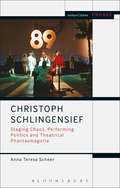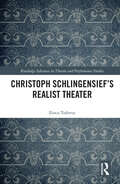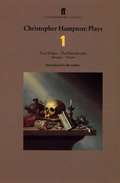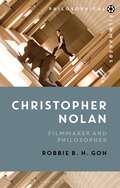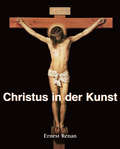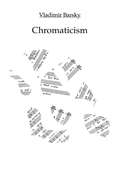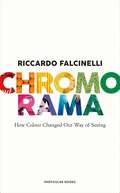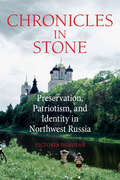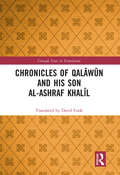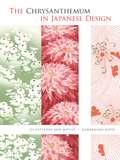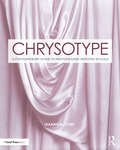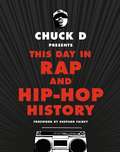- Table View
- List View
Christoph Schlingensief: Staging Chaos, Performing Politics and Theatrical Phantasmagoria (Methuen Drama Engage)
by Anna Teresa ScheerThe first book to focus specifically on the late German artist Christoph Schlingensief's theatre work, it subversively merges art, politics and everyday life to imbue his productions both inside and outside the theatre with a re-energized concept of the political in art. Scheer traces Schlingensief's artistic lineage as a filmmaker with no formal training in theatre, whose work does not correspond to theoretical frameworks such as postdramatic theatre, Regietheater, or established categories of political theatre such as Brechtian, community, and agit-prop theatre. She explores how his work instead draws upon the highly performative gestures of the historical and post-Cold War avant-gardes as well the happenings and event-based practices of the sixties. Comprehensive case studies of six diverse theatrical and activist events are offered to demonstrate both the immediacy of Schlingensief's response to contemporary social and political events and his use of a range of artistic influences and different genres: Rocky Dutschke '68 (1996), Save Capitalism: Throw the Money Away! (1999) The Berlin Republic – or the Ring in Africa (1999) Hamlet (2001), Atta Atta – Art Has Broken Out! (2003) and the Church of Fear (2003). Key questions such as how his theatre functions as a provocation, and how an artist can insert themselves into the powerful flows of imagery produced by the perpetual global news cycle, form a coherent line of enquiry throughout each of the chapters. The significance of Schlingensief's artistic legacy of politicized theatre-making that pioneers new modes of active, aesthetic and public engagement in the political realm remains pertinent to topical socio-political debates and is of relevance to an international audience across a diversity of disciplines.
Christoph Schlingensief's Realist Theater (Routledge Advances in Theatre & Performance Studies)
by Ilinca TodorutThis book is the first study of the prolific German filmmaker, performance artist, and TV host Christoph Schlingensief (1960–2010) that identifies him as a practitioner of realism in the theater and lays out how theatrical realism can offer an aesthetic frame sturdy enough to hold together his experiments across media and genres. This volume traces Schlingensief’s developing realism through his theater work in conventional theater venues, in less conventional venues, his opera work focusing on the production of Wagner’s Parsifal at Bayreuth, and his art installations on revolving platforms called Animatographs. This book will be of great interest to scholars of theater, film, and performance art and practitioners.
Christoph Schlingensief's Realist Theater (Routledge Advances in Theatre & Performance Studies)
by Ilinca TodorutThis book is the first study of the prolific German filmmaker, performance artist, and TV host Christoph Schlingensief (1960–2010) that identifies him as a practitioner of realism in the theater and lays out how theatrical realism can offer an aesthetic frame sturdy enough to hold together his experiments across media and genres. This volume traces Schlingensief’s developing realism through his theater work in conventional theater venues, in less conventional venues, his opera work focusing on the production of Wagner’s Parsifal at Bayreuth, and his art installations on revolving platforms called Animatographs. This book will be of great interest to scholars of theater, film, and performance art and practitioners.
Christopher Hampton Plays 1: Total Eclipse; The Philanthropist; Savages; Treats
by Christopher HamptonThis first collection of Hampton's work includes The Philanthropist, which premièred at the Royal Court Theatre in 1970 and went on to become one of the Court's longest-running West End transfers. The volume also contains Treats, Savages and Hampton's deeply affecting drama about the relationship of the French poets Rimbaud and Verlaine, Total Eclipse.
Christopher Nolan: Filmmaker and Philosopher (Philosophical Filmmakers)
by Robbie B. GohChristopher Nolan is the writer and director of Hollywood blockbusters like The Dark Knight and The Dark Knight Rises, and also of arthouse films like Memento and Inception. Underlying his staggering commercial success however, is a darker sensibility that questions the veracity of human knowledge, the allure of appearance over reality and the latent disorder in contemporary society. This appreciation of the sinister owes a huge debt to philosophy and especially modern thinkers like Friedrich Nietzsche, Sigmund Freud and Jacques Derrida. Taking a thematic approach to Nolan's oeuvre, Robbie Goh examines how the director's postmodern inclinations manifest themselves in non-linearity, causal agnosticism, the threat of social anarchy and the frequent use of the mise en abyme, while running counter to these are narratives of heroism, moral responsibility and the dignity of human choice. For Goh, Nolan is a 'reluctant postmodernist'. His films reflect the cynicism of the modern world, but with their representation of heroic moral triumphs, they also resist it.
Christopher Nolan: Filmmaker and Philosopher (Philosophical Filmmakers)
by Robbie B. GohChristopher Nolan is the writer and director of Hollywood blockbusters like The Dark Knight and The Dark Knight Rises, and also of arthouse films like Memento and Inception. Underlying his staggering commercial success however, is a darker sensibility that questions the veracity of human knowledge, the allure of appearance over reality and the latent disorder in contemporary society. This appreciation of the sinister owes a huge debt to philosophy and especially modern thinkers like Friedrich Nietzsche, Sigmund Freud and Jacques Derrida. Taking a thematic approach to Nolan's oeuvre, Robbie Goh examines how the director's postmodern inclinations manifest themselves in non-linearity, causal agnosticism, the threat of social anarchy and the frequent use of the mise en abyme, while running counter to these are narratives of heroism, moral responsibility and the dignity of human choice. For Goh, Nolan is a 'reluctant postmodernist'. His films reflect the cynicism of the modern world, but with their representation of heroic moral triumphs, they also resist it.
Christus in der Kunst
by Ernest RenanSeit der Geburt des Christentums sind Künstler fasziniert von Christus. Sein Abbild erscheint auf Fresken in Katakomben aus der Römerzeit, auf Buntglasscheiben in gotischen Kirchen sowie in verschiedenen Darstellungen in der heutigen Pop- Kultur. Der biblische Erlöser ist keine statische, körperlose Gottheit: Christi Geburt, sein ungewöhnliches Leben und sein dramatischer Tod machen ihn zu einem interessanten Motiv für religiöse und säkulare Künstler. Ob sie die Geistlichkeit des Leibhaftigen oder die menschlichen Charakteristika eines Mannes aus Fleisch und Blut zeigen, künstlerische Darstellungen Christi sind die umstrittensten, bewegendsten oder inspirierendsten Beispiele religiöser Kunst. Dieses reich illustrierte Buch erforscht verschiedene christliche Darstellungen, von Cimabues Krippenszenen über die Kreuzigungsdarstellungen Fra Angelicos bis hin zu den provozierenden Porträts Dalís und Andre Serranos. Der Autor Joseph Lewis French führt den Leser durch die ikonischen Darstellungen Christi in der Kunst. Zart oder graphisch, klassisch oder bizarr verdeutlichen diese Messiasbilder die verschiedenen Rollen des Gottessohns im sozialen Bereich wie auch im persönlichen Leben der Künstler.
Chroma: A Book of Colour - June '93
by Derek JarmanIn Chroma, Derek Jarman explains the use of colour in Medieval painting through the Renaissance to the modernists and draws on the great colour theorists from Pliny to Leonardo. He also talks about the meaning of colours in literature, science, philosophy, psychology, religion and alchemy. The colours on Jarman's palette are mixed with memory and insight to create an evocative and highly personal work.
Chromatic Algorithms: Synthetic Color, Computer Art, and Aesthetics after Code
by Carolyn L. KaneThese days, we take for granted that our computer screens—and even our phones—will show us images in vibrant full color. Digital color is a fundamental part of how we use our devices, but we never give a thought to how it is produced or how it came about. Chromatic Algorithms reveals the fascinating history behind digital color, tracing it from the work of a few brilliant computer scientists and experimentally minded artists in the late 1960s and early ‘70s through to its appearance in commercial software in the early 1990s. Mixing philosophy of technology, aesthetics, and media analysis, Carolyn Kane shows how revolutionary the earliest computer-generated colors were—built with the massive postwar number-crunching machines, these first examples of “computer art” were so fantastic that artists and computer scientists regarded them as psychedelic, even revolutionary, harbingers of a better future for humans and machines. But, Kane shows, the explosive growth of personal computing and its accompanying need for off-the-shelf software led to standardization and the gradual closing of the experimental field in which computer artists had thrived. Even so, the gap between the bright, bold presence of color onscreen and the increasing abstraction of its underlying code continues to lure artists and designers from a wide range of fields, and Kane draws on their work to pose fascinating questions about the relationships among art, code, science, and media in the twenty-first century.
Chromatic Algorithms: Synthetic Color, Computer Art, and Aesthetics after Code
by Carolyn L. KaneThese days, we take for granted that our computer screens—and even our phones—will show us images in vibrant full color. Digital color is a fundamental part of how we use our devices, but we never give a thought to how it is produced or how it came about. Chromatic Algorithms reveals the fascinating history behind digital color, tracing it from the work of a few brilliant computer scientists and experimentally minded artists in the late 1960s and early ‘70s through to its appearance in commercial software in the early 1990s. Mixing philosophy of technology, aesthetics, and media analysis, Carolyn Kane shows how revolutionary the earliest computer-generated colors were—built with the massive postwar number-crunching machines, these first examples of “computer art” were so fantastic that artists and computer scientists regarded them as psychedelic, even revolutionary, harbingers of a better future for humans and machines. But, Kane shows, the explosive growth of personal computing and its accompanying need for off-the-shelf software led to standardization and the gradual closing of the experimental field in which computer artists had thrived. Even so, the gap between the bright, bold presence of color onscreen and the increasing abstraction of its underlying code continues to lure artists and designers from a wide range of fields, and Kane draws on their work to pose fascinating questions about the relationships among art, code, science, and media in the twenty-first century.
Chromatic Algorithms: Synthetic Color, Computer Art, and Aesthetics after Code
by Carolyn L. KaneThese days, we take for granted that our computer screens—and even our phones—will show us images in vibrant full color. Digital color is a fundamental part of how we use our devices, but we never give a thought to how it is produced or how it came about. Chromatic Algorithms reveals the fascinating history behind digital color, tracing it from the work of a few brilliant computer scientists and experimentally minded artists in the late 1960s and early ‘70s through to its appearance in commercial software in the early 1990s. Mixing philosophy of technology, aesthetics, and media analysis, Carolyn Kane shows how revolutionary the earliest computer-generated colors were—built with the massive postwar number-crunching machines, these first examples of “computer art” were so fantastic that artists and computer scientists regarded them as psychedelic, even revolutionary, harbingers of a better future for humans and machines. But, Kane shows, the explosive growth of personal computing and its accompanying need for off-the-shelf software led to standardization and the gradual closing of the experimental field in which computer artists had thrived. Even so, the gap between the bright, bold presence of color onscreen and the increasing abstraction of its underlying code continues to lure artists and designers from a wide range of fields, and Kane draws on their work to pose fascinating questions about the relationships among art, code, science, and media in the twenty-first century.
Chromatic Algorithms: Synthetic Color, Computer Art, and Aesthetics after Code
by Carolyn L. KaneThese days, we take for granted that our computer screens—and even our phones—will show us images in vibrant full color. Digital color is a fundamental part of how we use our devices, but we never give a thought to how it is produced or how it came about. Chromatic Algorithms reveals the fascinating history behind digital color, tracing it from the work of a few brilliant computer scientists and experimentally minded artists in the late 1960s and early ‘70s through to its appearance in commercial software in the early 1990s. Mixing philosophy of technology, aesthetics, and media analysis, Carolyn Kane shows how revolutionary the earliest computer-generated colors were—built with the massive postwar number-crunching machines, these first examples of “computer art” were so fantastic that artists and computer scientists regarded them as psychedelic, even revolutionary, harbingers of a better future for humans and machines. But, Kane shows, the explosive growth of personal computing and its accompanying need for off-the-shelf software led to standardization and the gradual closing of the experimental field in which computer artists had thrived. Even so, the gap between the bright, bold presence of color onscreen and the increasing abstraction of its underlying code continues to lure artists and designers from a wide range of fields, and Kane draws on their work to pose fascinating questions about the relationships among art, code, science, and media in the twenty-first century.
Chromatic Cinema: A History of Screen Color
by Richard MisekChromatic Cinema provides the first wide-ranging historical overview of screen color, exploring the changing uses and meanings of color in moving images, from hand painting in early skirt dance films to current trends in digital color manipulation. Offers both a history and a theory of screen color in the first full-length study ever published Provides an in-depth yet accessible account of color's spread through and ultimate effacement of black-and-white cinema, exploring the technological, cultural, economic, and artistic factors that have defined this evolving symbiosis Engages with film studies, art history, visual culture and technology studies in a truly interdisciplinary manner Includes 65 full-color illustrations of films ranging from Expressionist animation to Hollywood and Bollywood musicals, from the US ’indie' boom to1980s neo-noir, Hong Kong cinema, and recent comic-book films
Chromaticism
by Vladimir BarskyFirst Published in 1996. Routledge is an imprint of Taylor & Francis, an informa company.
Chromaticism
by Vladimir BarskyFirst Published in 1996. Routledge is an imprint of Taylor & Francis, an informa company.
Chromorama: How Colour Changed Our Way of Seeing
by Riccardo FalcinelliThe Italian colour bible: a gorgeously illustrated exploration of colour and the modern gaze, from an award-winning designer'Fresh and exciting, like an unopened packet of coloured pencils. Countless thought-provoking facts to ponder over, beautifully written' Coralie Bickford-Smith, author of The Fox and the StarWhy are pencils yellow and white goods white? Why is black the colour of mourning? What connects Queen Victoria's mauve gown and Michelle Obama's yellow dress? In Chromorama, acclaimed graphic designer Riccardo Falcinelli delves deep into the history of colour to show how it has shaped the modern gaze. With over four hundred illustrations throughout and with examples ranging widely across art and culture - from the novels of Gustave Flaubert to The Simpsons, from Byzantine jewellery to misshapen fruit, from Mondrian to Hitchcock's thrillers - Falcinelli traces the evolution of our long relationship with colour, and how first the industrial revolution, and then the dawn of the internet age, changed it forever. Beautifully designed, deeply researched, and written with warmth and wit, Chromoroma is an engrossing account of shade and light, of tone and hue, of dyes, pigments, and pixels. It is the story of why we now see the world the way we do.
Chronicles in Stone: Preservation, Patriotism, and Identity in Northwest Russia (NIU Series in Slavic, East European, and Eurasian Studies)
by Victoria DonovanChronicles in Stone is a study of the powerful and pervasive myth of the Russian Northwest, its role in forming Soviet and Russian identities, and its impact on local communities. Combining detailed archival research, participant observation and oral history work, it explores the transformation of three northwestern Russian towns from provincial backwaters into the symbolic homelands of the Soviet and Russian nations.The book's central argument is that the Soviet state exploited the cultural heritage of the Northwest to craft patriotic narratives of the people's genius, heroism and strength that could bind the nation together after 1945. Through sustained engagement with local voices, it reveals the ways these narratives were internalized, revised, and resisted by the communities living in the region.Donovan provides an alternative lens through which to view the rise of Russian patriotic consciousness in the twentieth and twenty-first centuries, adding a valuable regional dimension to our knowledge of Russian nation building and identity politics.
Chronicles of Qalāwūn and his son al-Ashraf Khalīl (Crusade Texts in Translation)
by Translated by CookThis volume provides translations of texts on the Mamluk Sultan Qalāwūn (1279-90) and his son al-Malik al-Ashraf (1290-93), which cover the end of the Crusader interlude in the Syrian Levant. Translated from the original Arabic, these chronicles detail the Mamluk perception of the Crusaders, the Mongol menace, how this menace was confronted, and a wealth of materials about the Mediterranean basin in the late thirteenth century. Treaties, battles, sieges and embassies are all revealed in these chronicles, most of which have not been translated previously. The translated texts provide a range of historical records concerning Qalāwūn and al-Ashraf, and include the court perspective of Ibn `Abd al-Ẓāhir, the later biography by his nephew Shafī`, and the writings of the Mamluk historian Baybars al-Mansūrī.
Chronicles of Qalāwūn and his son al-Ashraf Khalīl (Crusade Texts in Translation)
by Translated by CookThis volume provides translations of texts on the Mamluk Sultan Qalāwūn (1279-90) and his son al-Malik al-Ashraf (1290-93), which cover the end of the Crusader interlude in the Syrian Levant. Translated from the original Arabic, these chronicles detail the Mamluk perception of the Crusaders, the Mongol menace, how this menace was confronted, and a wealth of materials about the Mediterranean basin in the late thirteenth century. Treaties, battles, sieges and embassies are all revealed in these chronicles, most of which have not been translated previously. The translated texts provide a range of historical records concerning Qalāwūn and al-Ashraf, and include the court perspective of Ibn `Abd al-Ẓāhir, the later biography by his nephew Shafī`, and the writings of the Mamluk historian Baybars al-Mansūrī.
The Chrysanthemum in Japanese Design: 121 Patterns and Motifs
by Kawarasaki KotoImported from China during the 8th century, the chrysanthemum is the official flower of Japan. The Japanese monarchy is known as The Chrysanthemum Throne, and the exquisite blossom is widely revered as a symbol of longevity, dignity, and nobility. This volume, reproduced from a rare and expensive publication, features more than 120 color woodblock images of the breathtaking perennials.
Chrysanthemums: Beautiful varieties for home and garden
by null Naomi Slade null Georgianna LaneThe underestimated Chrysanthemum is the epitome of both flamboyance and style with it’s many varieties and shapes: chronicled beautifully in Naomi Slades Chrysanthemums. The next title in Pavilion’s best-selling series of stylish floral guides, Chrysanthemums celebrates the versatility and variety of this familiar yet surprising bloom. As a life-giving herb in ancient China, a cultural emblem in Japan and a design icon of the Arts and Crafts movement, the chrysanthemum has been lauded through the ages. Yet in recent years it has gained a reputation as something of a workhorse among cut flowers, thanks to its reliable, long-lasting blooms and sturdy stems. More recently, resurgent interest in heritage varieties and new developments in growing and propagating have meant that the future of the flower is changing. As a cut flower, the exotic, decadent blooms and adaptable sprays of buttons are winning hearts and attracting new admirers, while the hardy and tenacious garden varieties are experiencing a long-overdue resurgence. Chrysanthemums explores cultivated chrysanthemums in all their glory, from the rare and interesting to the glamorous and ubiquitous, via those that are simply excellent garden plants. It delights in their form, fragrance and colour, digs into their history and rejoices in one of the finest cut flowers around. The huge variety of the genus Chrysanthemum is illuminated in captivating text by gardening journalist, author and designer Naomi Slade, while the elegant and characterful blooms are captured in gorgeous colour by photographer Georgianna Lane. The chrysanthemum is the perfect flower for weddings, gift bouquets and to brighten your home, and with expert advice and commentary, this book is ideal for anyone wanting to propagate, grow, cut, or simply admire this fabulous bloom.
Chrysotype: A Contemporary Guide to Photographic Printing in Gold (Contemporary Practices in Alternative Process Photography)
by Leanne McPheeChrysotype is about photographic printing in gold on paper. This 19th century printing process, modified for contemporary use, provides artists with an affordable way to produce permanent prints in gold. By using film or digital negatives, striking hand-coated prints can be created in monochromatic hues ranging from pink, violet, magenta and purple, to green, blue, grey and black. Chrysotype offers a how-to guide for intermediate practitioners with illustrated examples and simple explanations for each stage of the chrysotype process. The book is divided into three sections: history; preparation and how-to; and the work of contemporary artists using chrysotype. This book includes: A concise account of the invention and modification of the chrysotype process, including early discoveries about gold and colour and the significance of moisture for printing in gold How to set up your workspace for printing, including useful equipment and materials Advice on safe chemical practice A step-by-step guide to creating suitable digital and film negatives Guidance on paper selection and how to successfully coat paper An overview guide to creating a chrysotype print Step-by step directions for creating the chrysotype solutions An explanation of mixing ratios and solution volumes that control contrast An illustrated explanation of the effect of humidity on colour, including split tone colours and ways to control humidity Step-by-step directions on post-exposure hydration to lengthen tonal range and lower contrast Step-by-step tray processing directions Advanced techniques such as handling translucent papers, additional chrysotype formulas and procedures, and alternative developing agents that support longer development, colour formation and remedy problems that affect image quality Troubleshooting chrysotype printing, including advice and photographic examples Illustrated profiles of contemporary artists making chrysotype prints, including their methods and tips Chrysotype serves to inform, encourage and challenge a new generation of alternate process practitioners and a growing chrysotype community, from the newly curious to the experienced professional.
Chrysotype: A Contemporary Guide to Photographic Printing in Gold (Contemporary Practices in Alternative Process Photography)
by Leanne McPheeChrysotype is about photographic printing in gold on paper. This 19th century printing process, modified for contemporary use, provides artists with an affordable way to produce permanent prints in gold. By using film or digital negatives, striking hand-coated prints can be created in monochromatic hues ranging from pink, violet, magenta and purple, to green, blue, grey and black. Chrysotype offers a how-to guide for intermediate practitioners with illustrated examples and simple explanations for each stage of the chrysotype process. The book is divided into three sections: history; preparation and how-to; and the work of contemporary artists using chrysotype. This book includes: A concise account of the invention and modification of the chrysotype process, including early discoveries about gold and colour and the significance of moisture for printing in gold How to set up your workspace for printing, including useful equipment and materials Advice on safe chemical practice A step-by-step guide to creating suitable digital and film negatives Guidance on paper selection and how to successfully coat paper An overview guide to creating a chrysotype print Step-by step directions for creating the chrysotype solutions An explanation of mixing ratios and solution volumes that control contrast An illustrated explanation of the effect of humidity on colour, including split tone colours and ways to control humidity Step-by-step directions on post-exposure hydration to lengthen tonal range and lower contrast Step-by-step tray processing directions Advanced techniques such as handling translucent papers, additional chrysotype formulas and procedures, and alternative developing agents that support longer development, colour formation and remedy problems that affect image quality Troubleshooting chrysotype printing, including advice and photographic examples Illustrated profiles of contemporary artists making chrysotype prints, including their methods and tips Chrysotype serves to inform, encourage and challenge a new generation of alternate process practitioners and a growing chrysotype community, from the newly curious to the experienced professional.
Chuck D Presents This Day in Rap and Hip-Hop History
by Chuck DA one-of-a kind survey of rap and hip hop history from 1973 to today by Chuck D, arguably the most influential rapper in the world.In the more than 40 years since the days of DJ Kool Herc and "Rapper's Delight," hip hop and rap have become a billion-dollar worldwide phenomenon. Yet there is no definitive history of the genre-until now.Based on Chuck's long-running show on Rapstation.com, this massive compendium details the most iconic moments and influential songs in the genre's recorded history, from Kurtis Blow's "Christmas Rappin'" to The Miseducation of Lauryn Hill to Kendrick Lamar's ground-breaking verse on "Control." Also included are key events in hip hop history, from Grandmaster Flash's first scratch through Tupac's holographic appearance at Coachella.Throughout, Chuck offers his insider's perspective on the chart toppers and show stoppers as he lived it. Illustrating the pages are more than 100 portraits from the talented artists specializing in hip hop.
